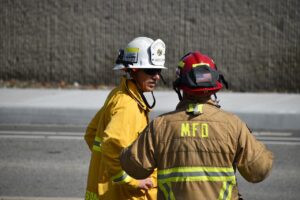Note: The following article is a comprehensive guide on cleaning firefighter turnout gear to ensure safety and extend the lifespan of the equipment. It provides step-by-step instructions, best practices, and precautions for cleaning and maintaining the gear. Please consult with the manufacturer for specific guidelines and requirements.
Introduction
Cleaning firefighter turnout gear is crucial for maintaining the safety and functionality of the equipment. Soiled or contaminated gear not only poses a risk to firefighters but can also compromise the protective performance of the gear. Regular and proper cleaning helps remove contaminants, extends the life of the gear, and ensures optimal protection. In this article, we will explore the importance of cleaning firefighter turnout gear and provide detailed instructions on how to clean and care for it effectively.
The Dangers of Dirty Turnout Gear
Dirty turnout gear is more than just an aesthetic issue. It can present various hazards to firefighters. When gear is grimy, the heat resistance provided by it can be compromised, which can be a matter of life and death in extreme temperatures. Soot that accumulates on fire gear over time can make it ignitable, increasing the risk of burns. Unclean gear also allows harmful chemicals found in soot, like Benzene, to gather, increasing the exposure to cancer-causing contaminants. Additionally, soiled gear can darken reflective striping, reducing visibility and increasing the risk of accidents.
The Cleaning Process: Step-by-Step
Cleaning firefighter turnout gear requires a systematic approach to ensure thorough and effective cleaning. Here is a step-by-step guide to cleaning and caring for your gear:
Step 1: Pre-Cleaning at the Scene
Immediately after a fire, it is essential to clean the gear before leaving the scene. This reduces the exposure risk from harmful particulates and chemicals to both yourself and others. Brush off debris and rinse the gear with water to remove loose contaminants.
Step 2: Inspect and Disassemble
Next, thoroughly inspect the gear and disassemble it as necessary. Wear eye protection and gloves during this step. Check for any damage, such as holes, and repair them promptly. If the liners and/or the DRD (Detachable Reflective Trim) are detachable, remove them from the shell for separate cleaning.
Step 3: Pretreat and Machine Wash
Before machine washing, pretreat areas that are heavily soiled. Use a specialty turnout gear cleaner or spotter with a neutral pH to treat stubborn stains. Then, wash the turnout gear outer shells and liners separately in a front-loading washing machine. Avoid using high-velocity power washers or top-loading agitator machines, as they may damage the gear.
Step 4: Re-Inspect and Re-Wash
Once the washing is complete, carefully inspect the gear again. If any areas are still not clean, repeat the washing process. Ensure that all closures, such as hooks and loops, zippers, and snaps, are fastened correctly.
Step 5: Drying
Proper drying is vital to prevent mold, bacteria growth, and thermal instability. Dry the gear in a fire department gear dryer or hang it in a shaded area with good cross ventilation. Avoid direct sunlight and excessive heat during the drying process. Ensure that temperatures do not exceed 105 degrees Fahrenheit.
Step 6: Reassemble and Store
Once the gear is fully dried, reassemble all components and ensure everything is properly secured. Store the gear in an area away from direct sunlight and extreme temperatures. Follow the manufacturer’s instructions for specific storage recommendations.
The Importance of Fire Gear Dryers
Investing in a high-quality fire gear dryer is crucial for ensuring thorough and efficient drying of turnout gear. A fire gear dryer can quickly dry wet gear, reducing downtime between fire calls and preventing thermal instability. Proper drying also helps eliminate bacteria and mold growth, which can adversely affect health. Look for dryers that are freestanding or wall-mounted, have specialty ports for drying different equipment, are durable, and have proven effectiveness in eliminating bacteria.
Choosing the Right Cleaning Products
When cleaning firefighter turnout gear, it is essential to use the correct cleaning products to maintain the integrity and performance of the gear. Choose specialty turnout gear cleaners and spotters with a neutral pH (between 5.0 and 10.5) from reputable companies. These products are specifically designed for cleaning turnout gear and help prevent soil redeposition. Avoid using cleaning agents with a pH greater than 10.5 or chlorine bleach, as they can cause irreversible damage to the gear.
Routine Inspection and Cleaning Best Practices
Regular inspection and cleaning of firefighter turnout gear are essential for identifying any issues and ensuring optimal performance. Here are some best practices to follow:
Conduct routine inspections after each use to check for soiling, contamination, physical damage, damaged trim, and closures.
Perform advanced inspections at least every 12 months or when routine inspections indicate a problem. Focus on moisture barrier and seam sealing integrity, fit and coat/pants overlap, seam integrity, material integrity, liner attachment systems, and reflective trim.
Follow the recommended cleaning procedures for routine and advanced cleaning, including pre-treatment, utility sink cleaning, or machine washing.
Avoid high-velocity power washers, scrubbing vigorously with brushes, using cleaning agents with a pH greater than 10.5, or chlorine bleach.
Separate cleaning and decontamination of protective clothing from non-protective items.
Air dry gear in a well-ventilated area or use a fire gear dryer with appropriate temperature settings.
Conclusion
Cleaning firefighter turnout gear is a critical aspect of ensuring the safety and longevity of the equipment. By following proper cleaning procedures, you can remove contaminants, maintain the protective performance of the gear, and extend its lifespan. Regular inspections and adherence to manufacturer guidelines are essential for identifying any issues and taking appropriate action. Invest in high-quality cleaning products and fire gear dryers to optimize the cleaning process. By prioritizing the cleaning and care of firefighter turnout gear, you can enhance the safety and effectiveness of firefighting operations. Stay safe!








